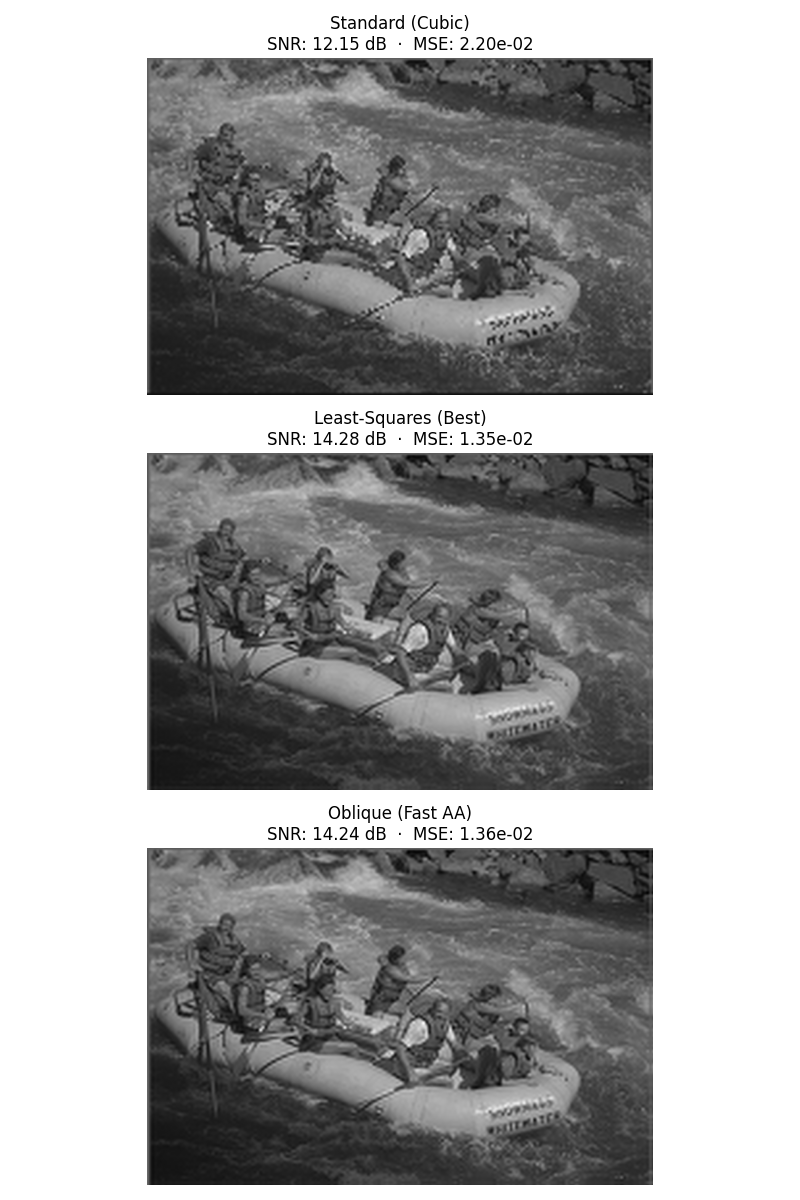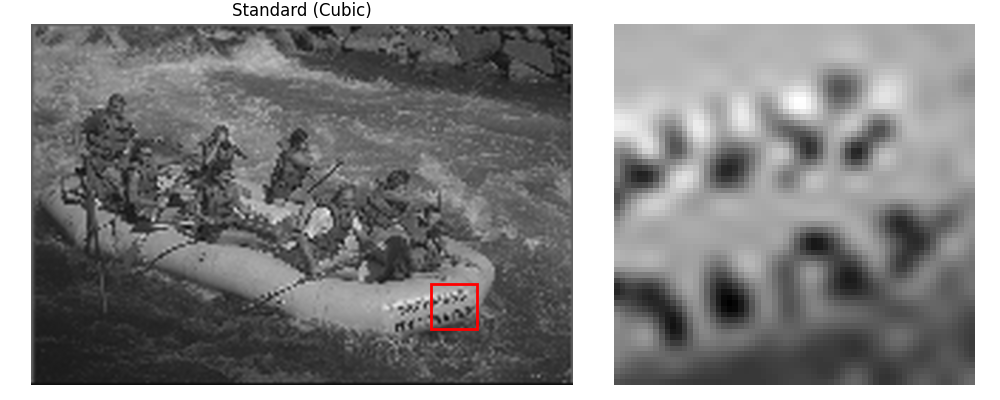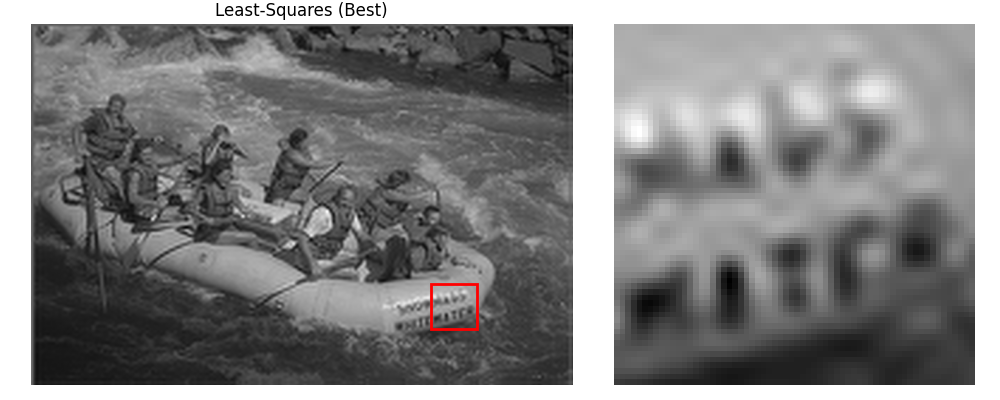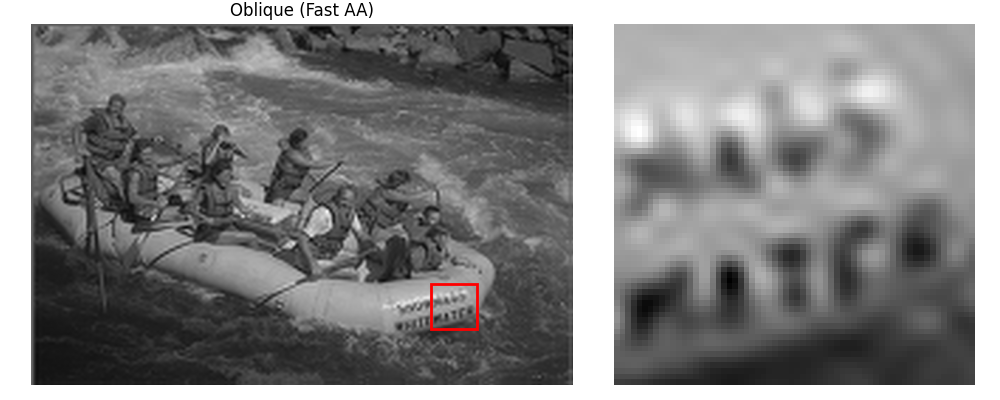Compare Different Methods#
A summary of the cost/benefit tradeoff of the three interpolation methods is provided in this example.
Imports#
import numpy as np
import matplotlib.pyplot as plt
import requests
from io import BytesIO
from PIL import Image
from splineops.utils import (
resize_and_compute_metrics, # resampling + metrics
show_roi_zoom,
)
Load and Normalize an Image#
Here, we load an example image from an online repository. We convert it to grayscale in [0, 1].
url = 'https://r0k.us/graphics/kodak/kodak/kodim14.png'
response = requests.get(url)
img = Image.open(BytesIO(response.content))
data = np.array(img, dtype=np.float64)
# Convert to [0..1]
input_image_normalized = data / 255.0
# Convert to grayscale via simple weighting
input_image_normalized = (
input_image_normalized[:, :, 0] * 0.2989 + # Red channel
input_image_normalized[:, :, 1] * 0.5870 + # Green channel
input_image_normalized[:, :, 2] * 0.1140 # Blue channel
)
zoom_factors_2d = (0.25, 0.25)
border_fraction = 0.3
# --- ROI: match the LS/Oblique examples ---
ROI_SIZE_PX = 64
FACE_ROW, FACE_COL = 400, 600 # ROI center in ORIGINAL coordinates
h_img, w_img = input_image_normalized.shape
row_top = int(np.clip(FACE_ROW - ROI_SIZE_PX // 2, 0, h_img - ROI_SIZE_PX))
col_left = int(np.clip(FACE_COL - ROI_SIZE_PX // 2, 0, w_img - ROI_SIZE_PX))
roi_rect = (row_top, col_left, ROI_SIZE_PX, ROI_SIZE_PX) # (r, c, h, w)
# Reusable kwargs for consistent ROI zooms below
roi_kwargs = dict(
roi_height_frac=ROI_SIZE_PX / h_img,
grayscale=True,
roi_xy=(row_top, col_left),
)
Standard Interpolation#
We use our standard interpolation method.
(
resized_2d_interp,
recovered_2d_interp,
snr_2d_interp,
mse_2d_interp,
time_2d_interp
) = resize_and_compute_metrics(
input_image_normalized,
method="cubic",
zoom_factors=zoom_factors_2d,
border_fraction=border_fraction,
roi=roi_rect, # <-- compute metrics on the shared ROI
)
Least-Squares Projection#
We use the least-squares projection method.
(
resized_2d_ls,
recovered_2d_ls,
snr_2d_ls,
mse_2d_ls,
time_2d_ls
) = resize_and_compute_metrics(
input_image_normalized,
method="cubic-best_antialiasing",
zoom_factors=zoom_factors_2d,
border_fraction=border_fraction,
roi=roi_rect, # <-- compute metrics on the shared ROI
)
Oblique Projection#
We use the oblique-projection method.
(
resized_2d_ob,
recovered_2d_ob,
snr_2d_ob,
mse_2d_ob,
time_2d_ob
) = resize_and_compute_metrics(
input_image_normalized,
method="cubic-fast_antialiasing",
zoom_factors=zoom_factors_2d,
border_fraction=border_fraction,
roi=roi_rect, # <-- compute metrics on the shared ROI
)
Comparison#
We compare the performance of the different methods being analyzed.
Comparison Table#
We print the SNR, MSE, and timing data for each method.
methods = [
("Standard Interpolation", snr_2d_interp, mse_2d_interp, time_2d_interp),
("Least-Squares Projection", snr_2d_ls, mse_2d_ls, time_2d_ls),
("Oblique Projection", snr_2d_ob, mse_2d_ob, time_2d_ob),
]
# Print the table header using the same widths as we'll use for data
header_line = f"{'Method':<25} {'SNR (dB)':>10} {'MSE':>16} {'Time (s)':>12}"
print(header_line)
print("-" * len(header_line)) # or manually set a dash length, e.g. 67
# Now print each row with the matching format
for method_name, snr_val, mse_val, time_val in methods:
row_line = f"{method_name:<25} {snr_val:>10.2f} {mse_val:>16.2e} {time_val:>12.4f}"
print(row_line)
Method SNR (dB) MSE Time (s)
------------------------------------------------------------------
Standard Interpolation 12.15 2.20e-02 0.0187
Least-Squares Projection 14.28 1.35e-02 1.4392
Oblique Projection 14.24 1.36e-02 1.1208
All Methods#
recovered_stack = [
("Standard (Cubic)", recovered_2d_interp, snr_2d_interp, mse_2d_interp),
("Least-Squares (Best)", recovered_2d_ls, snr_2d_ls, mse_2d_ls),
("Oblique (Fast AA)", recovered_2d_ob, snr_2d_ob, mse_2d_ob),
]
fig, axes = plt.subplots(3, 1, figsize=(8, 12))
for ax, (label, img, snr_val, mse_val) in zip(axes, recovered_stack):
ax.imshow(img, cmap="gray", aspect="equal")
ax.set_title(f"{label}\nSNR: {snr_val:.2f} dB · MSE: {mse_val:.2e}")
ax.axis("off")
plt.tight_layout()
plt.show()

Standard Interpolation#
_ = show_roi_zoom(
recovered_2d_interp, # image to inspect
ax_titles=("Standard (Cubic)", None), # customise left title; right auto
**roi_kwargs
)

Least-Squares Projection#
_ = show_roi_zoom(
recovered_2d_ls, # image to inspect
ax_titles=("Least-Squares (Best)", None), # customise left title; right auto
**roi_kwargs
)

Oblique Projection#
_ = show_roi_zoom(
recovered_2d_ob, # image to inspect
ax_titles=("Oblique (Fast AA)", None), # customise left title; right auto
**roi_kwargs
)

Total running time of the script: (0 minutes 9.684 seconds)
